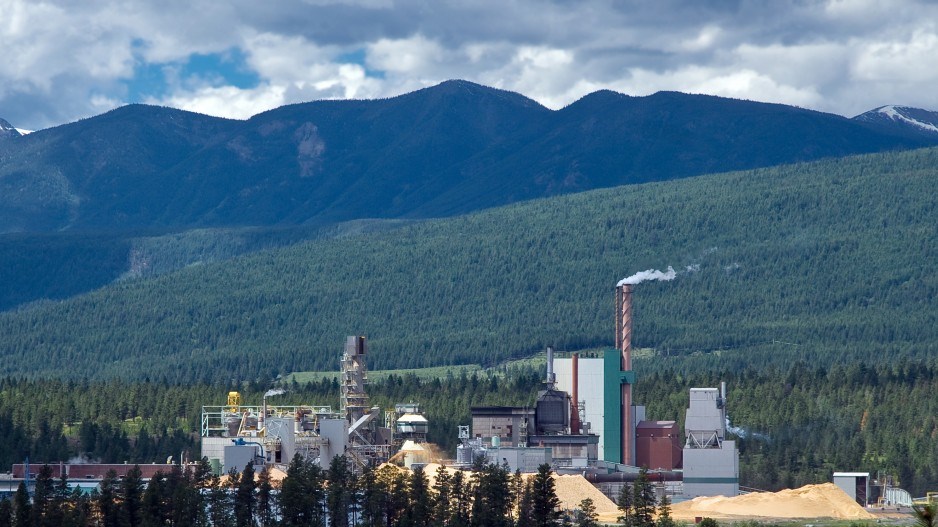Since 2005, 35 sawmills in B.C.’s Interior and nine on the coast have permanently shuttered, along with about half of the coastal shake and shingle mills, according to a new socioeconomic analysis of forestry in B.C.
According to Statistic Canada, forestry in B.C. sustained more than 200,000 jobs (direct and indirect) in 2001. That has since been cut in half to about 100,000 jobs today, 50,000 of which are direct jobs.
In the Interior, the annual allowable cut (AAC) has been dramatically reduced by a mountain pine beetle infestation. On the coast, a sizable chunk of the coastal AAC has been lost to new parks and protected areas.
B.C. can expect to see another four sawmills on the coast and five in the Interior permanently shut down, if the policy reforms demanded by environmentalists and the federal government are fully implemented.
That estimate comes from a new socio-economic impact study conducted by independent forestry consultants Jim Girvan and Rob Schuetz on behalf of a number of forest industry clients. Their outlook is not a worst-case scenario – which would be a total ban on all old-growth logging.
The study was intended to show the public and government just what it’s in for, if the government concedes to environmental demands.
“The public and environmentalists don’t understand what they’re actually asking for here,” Girvan said. “They’re asking to collapse an industry in British Columbia that supports 100,000 jobs.”
Girvan has a track record for accurately predicting mill closures in B.C. In 2010, he predicted 16 Interior lumber, veneer and plywood mills would shut down in B.C. by 2019 – which is how many did.
“In 2018, we said there’s another 13 mills that are going to close,” Girvan said. “The next day, they started going down.”
Six mills were permanently shuttered in 2019 alone.
Girvan now warns of another wave of mill closures, should the B.C. government accept all the recommendations made by environmentalists, including bans on logging in old-growth forests. If implemented, the policy changes being considered could result in a one-million-cubic-metre decrease in the coastal AAC and three-million-cubic-metre decrease for the Interior, according to the calculations of Girvan and Schuetz.
“Add on all the rest of the issues, and the reality is we’re looking at five to 10 more mills,” Girvan said.
Once that many sawmills shut down, pulp mills could be the next, because they rely on sawmill waste. In communities like Powell River, Port Alberni and Nanaimo, pulp and paper mills are major employers and taxpayers, and the economic impact of their closure can be severe.
“A 1% reduction in the cut, that’s a sawmill somewhere in the province,” Girvan said. “You start doing six and eight and 10 of those, now pulp mills are at risk. There’s probably pellet plants that are going to be at risk and [bioenergy] power plants that are going to be at risk because they all rely on the existing stable of sawmills that operate in this province.”
While the protests on Vancouver Island against the logging of old-growth forests have received most of the media attention, there are also ongoing blockades and protests against logging in the Revelstoke, Nelson and Prince George regions.
Bans on logging in old-growth forests would have the most impact for the coastal industry, although it would also affect the Interior. Meanwhile, caribou protection mandates, which are coming mainly from the federal government, would also reduce the AAC for the Interior forest industry.
These plans are intended to protect dwindling caribou herds, many of which are deemed to be at risk. A plan to protect the southern mountain caribou in the Peace region is already in place.
“That plan is being extended to all the other herds,” Girvan said.
If the Peace region plan is repeated for all other caribou herds, Girvan estimates it will remove 10% of the Interior AAC.
“We reviewed it with government,” Girvan said. “We said we think the impact’s about 10% of the Interior cut, and they said, ‘Yeah, that’s about what we think, too.’ So we kind of got some checkmarks when we reviewed this stuff with government that it was reasonable.”
Girvan said the industry accepts that it will lose some timber to things like caribou habitat protection. He said some trade-offs could be made that would mitigate the impact of an ever-shrinking timber supply, one of which would be allowing commercial thinning, which might at least save pulp mills.
Commercial thinning is when loggers go into younger, dense stands of forest that are not yet ready for conventional harvest, and weed out some of damaged or deformed trees for pulp wood.
“Commercial thinning is a big hitter,” Girvan said. “It could probably offset 10% or 20% of what the downfall might be. The industry has been pushing for larger-scale commercial thinning, like they do in most other jurisdictions in the world, but for whatever reason, government just doesn’t want to go down this path.”
The provincial government recently struck an old-growth review panel to try to come up with a plan to protect the most at-risk old-growth trees. Whatever the panel ends up recommending, Girvan does not expect it will satisfy environmentalists.
“Will the Sierra Club or WC squared (Western Canada Wilderness Committee) or Stand, are they all going to accept that – if we protect some of them but not all of them – the protests will end? I’ll bet my pension no way.”
Asked to comment on the socio-economic study, the Ministry of Forests, Lands and Natural Resources confirmed it had received the report.
“Ministry staff have received a presentation from Jim Girvan on his report and are in the process of reviewing its methodology for accuracy,” the ministry said in an email.
— Business in Vancouver



